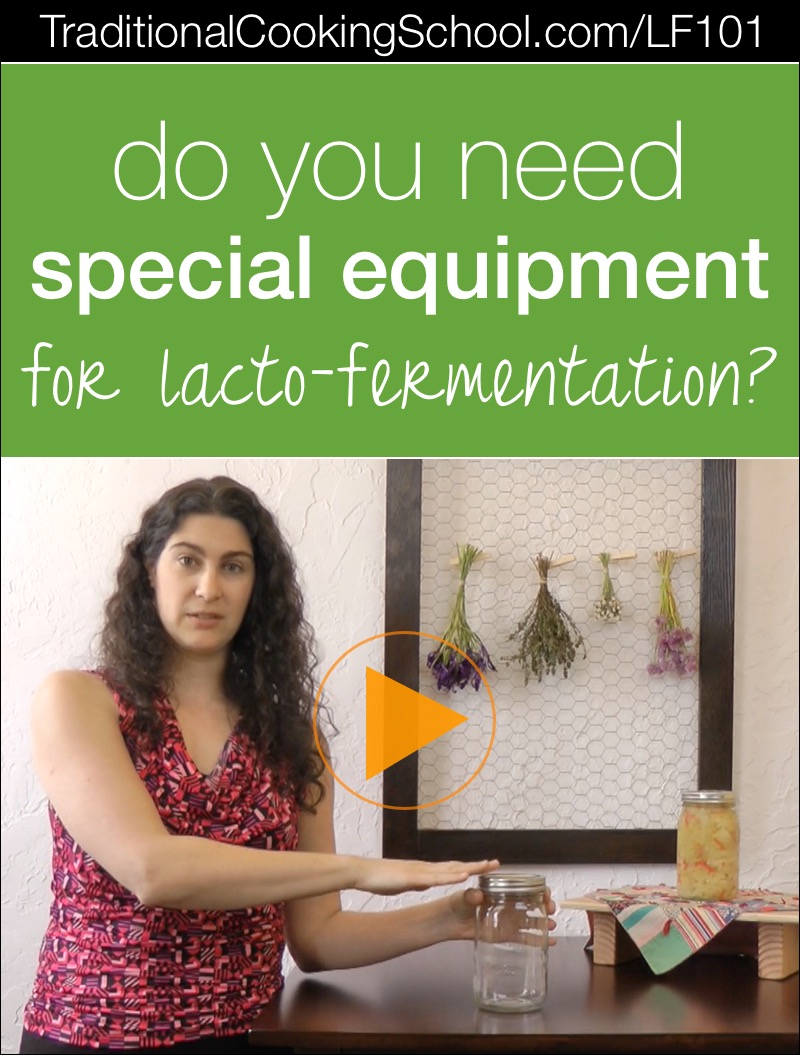
Do you need special equipment for lacto-fermentation?
As the author of The Complete Idiot’s Guide to Fermenting Foods and through teaching Lacto-Fermentation at Traditional Cooking School, I’ve received lots of questions about fermenting over the years.
Are you wondering how much salt to use, what salt to use, how to store ferments, if fermenting is safe, or other fermenting questions? This video series will answer them!
The Lacto-Fermentation 101 Video series today covers…
Do You Need Special Equipment for Lacto-Fermentation?
No, you don’t. Beyond the usual kitchen utensils (like spoons and knives) you only need fermenting containers, and mason jars with metal bands and lids are ideal. (I prefer wide-mouth quart.) Really, this is all you need!
Later on, when you really get into it, you can invest in special fermenting equipment such as airlock lids or specialty beverage bottles.
The airlock lid I love is the Pickle Pro from Homesteader Supply. It’s a modified Tattler canning lid and fits on a wide mouth jar. When the ferment is done, you can swap the airlock for a regular lid to store in the fridge, then use the airlock lid for another ferment.
See more in the video above. 🙂
Links Mentioned
- Free Fermenting Formulas Cheat Sheet
- The Complete Idiot’s Guide to Fermenting Foods
- Fermentation Troubleshooting & FAQs
- Subscribe to TCS on YouTube
- Pickle Pro Lids from Homesteader Supply
- Prepper Pro (Kraut Pounder) from Homesteader Supply
- Grolsch-style beverage bottles from Cultures for Health
- Wide-mouth quart jars on Amazon.com
What equipment do you use for fermentation? What do you consider optional and what do you consider necessary?
...without giving up the foods you love or spending all day in the kitchen!

2 free books:
Eat God's Way
Ditch the Standard American Diet, get healthier & happier, and save money on groceries...
We only recommend products and services we wholeheartedly endorse. This post may contain special links through which we earn a small commission if you make a purchase (though your price is the same).


Hi Wardee
I have been making your lacto-fermented tomato sauce, for some time now, using the whey from yoghurt. We find that the sauce becomes sort of lumpy/ jelly like – almost sort of curdled. In other words, not a smooth sauce. Is this due to the whey or possibly the apple cider vinegar?
In any event, it is delicious, as you say, and very satisfying to make it and know exactly what is in it.
Many thanks, Marea
Is it okay to pour the contents after fermented into another jar?
Hi Debby,
You can move finished ferments to a different jar/container. Be sure to also move to cold storage. 🙂
~Millie, TCS Customer Success Team
What is the recommended temperature range for Cold Storage??
Hi Deborah,
Most people now store lacto-fermented food in a refrigerator. Traditional societies stored their fermented foods in root cellars, caves, etc. You want to keep the temperature in the 32ºF to 50ºF range.
~Millie, TCS Customer Success Team